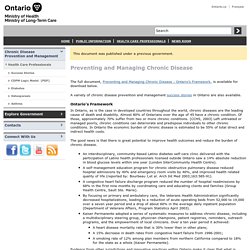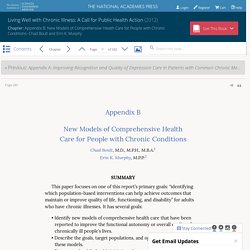

Canada needs a nation-wide diabetes strategy now - Diabetes Canada. International Diabetes Federation - Home. One night, everything went terribly wrong - Diabetes Canada. Framework full. Home page. Chp global forum brochure. Chronic Disease Management. What is chronic disease?

Do you live with a health conditions that requires ongoing management? These are called chronic health conditions and include things like diabetes, obesity, high blood pressure and some cancers. Chronic disease in Alberta Approximately 30 per cent of Albertans report having at least one chronic health condition and that number increases to over 75 per cent if you are 65 years of age or older. It’s projected that by 2031, one in five Albertans will be a senior which will increase the demand on our health care system to manage more chronic disease. These stats highlight the importance of providing support and education around chronic disease management to Albertans across the province.
Living with a chronic condition Alberta Health Services along with community partners and family doctors offer a wide range of resources to help those living with chronic conditions so they can live a long, happy and healthy life. 12875 2017 Article 692. HCC SelfManagementReport FA. Infection prevention and control guideline for cystic fibrosis 2013 update. What Is Cystic Fibrosis? Virtual Care in Action - OTN.ca. Preventing and Managing Chronic Disease - Health Care Professionals. This document was published under a previous government.

The full document, Preventing and Managing Chronic Disease : Ontario’s Framework, is available for download below. A variety of chronic disease prevention and management success stories in Ontario are also available. Ontario's Framework In Ontario, as is the case in developed countries throughout the world, chronic diseases are the leading cause of death and disability. Almost 80% of Ontarians over the age of 45 have a chronic condition. The good news is that there is great potential to improve health outcomes and reduce the burden of chronic disease. Evidence from other jurisdictions and innovative practices within Ontario make it clear that what is needed is a fundamentally different way of addressing chronic disease – a systems approach to prevention and management that : Although Ontario is making inroads, it can do much to improve its approach to chronic disease prevention and management.
For More Information. Chronic Disease Prevention and Management. March 2007 ISBN 978-0-662-45024-5 (PDF version) Cat.

H21-286/1-2007E-PDF (PDF version) This report is one in a series of five syntheses of Primary Health Care Transition Fund (PHCTF) initiative results addressing the following topics: Chronic Disease Prevention and Management, Collaborative Care, Evaluation and Evidence and Information Management and Technology. The fifth report is an overall analysis on the role and impact of the PHCTF in primary health care renewal entitled Laying the Groundwork for Culture Change: The Legacy of the Primary Health Care Transition Fund. All are available electronically on the PHCTF Web site (www.healthcanada.gc.ca/phctf), which also contains information on individual PHCTF initiatives.
Table of Contents Preface When Canadians need health care, most often they turn to primary health care (PHC) services.Footnote 1 PHC is the first point of contact with the health care system, and traditionally has focused on the role of family physicians. Acknowledgements. Patient Registry. Chronic Disease Prevention and Management. Appendix B: New Models of Comprehensive Health Care for People with Chronic Conditions. Unützer, J., W.

Katon, C.M. Callahan, J.W. Williams, Jr., E. Hunkeler, L. Unützer, J., W.

: Lap-Chee Tsui. The Story Richard Rozmahel passes time by reading the bulletin board hanging above the wheezing printer attached to the DNA sequencer.

There’s an advertisement from a company selling genetic research chemicals. They’re offering a free T-shirt sporting the words: Ultra Pure Human Being. At the bottom of the ad he reads, “Send six peel-off seals from any GIBCO BRL Enzymes and receive an I Make My Living Manipulating DNA briefcase free.” Ain’t it the truth, thinks Rozmahel to himself as he pulls yet another variation of the same tedious experiment from the printer. Rozmahel stops suddenly, just before he gets to his desk. Instead of sitting down at his desk, Rozmahel rushes to show his supervisor, Dr. Tsui’s office is small. “What is it, Richard?” “I’m pretty sure I’ve found a three-base-pair deletion. Tsui looks at the printout and says, “This is very good, Richard. But Tsui remembers that day — May 9, 1989 — as the day they discovered the gene for cystic fibrosis. As A Young Scientist... The Toronto Adult Cystic Fibrosis Centre.
2017 Registry Annual Data Report. Quick Facts from the 2017 Canadian CF Registry ANNUAL DATA ReporT The national Canadian CF Registry was created in the early 1970s with the goal of monitoring important clinical trends in the Canadian CF population.

The Registry has played an invaluable role in helping to improve the quality and length of life of people with cystic fibrosis. Since the majority of CF patients attend one of 42 accredited CF clinics (paediatric and adult) within Canada, it is felt that the Canadian CF Registry is very complete (i.e. it includes data on virtually all Canadians with cystic fibrosis) — giving a comprehensive picture of the CF population in this country. The Changing Microbial Epidemiology in Cystic Fibrosis. Clinical Microbiology Reviews 2010 LiPuma 299.